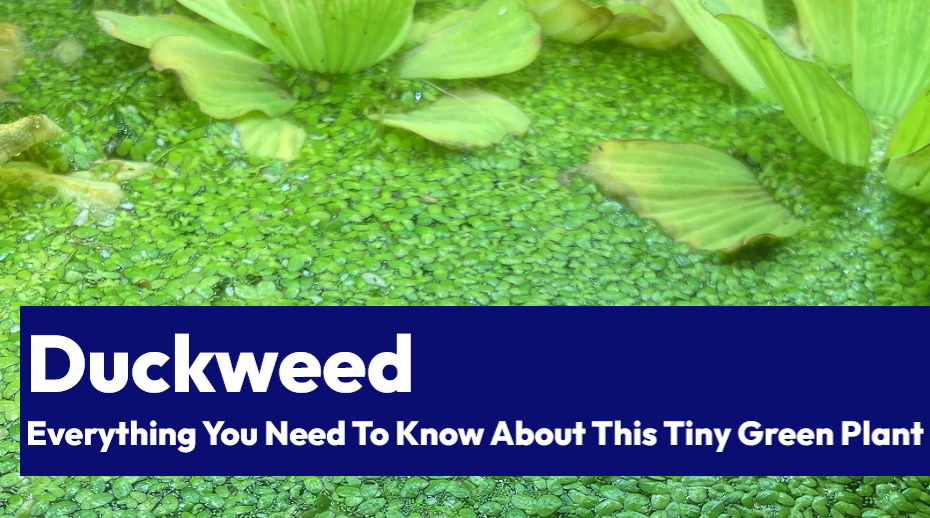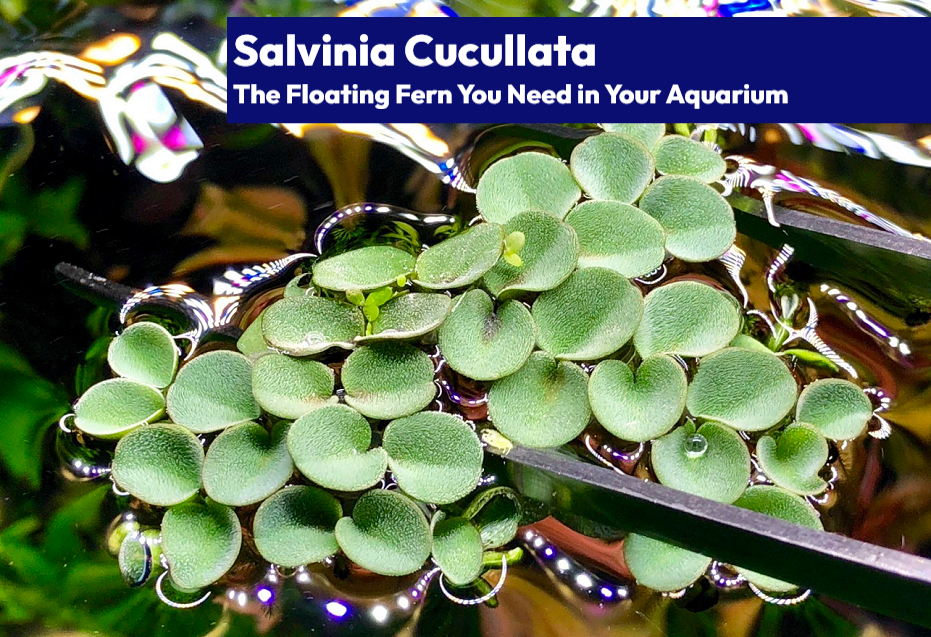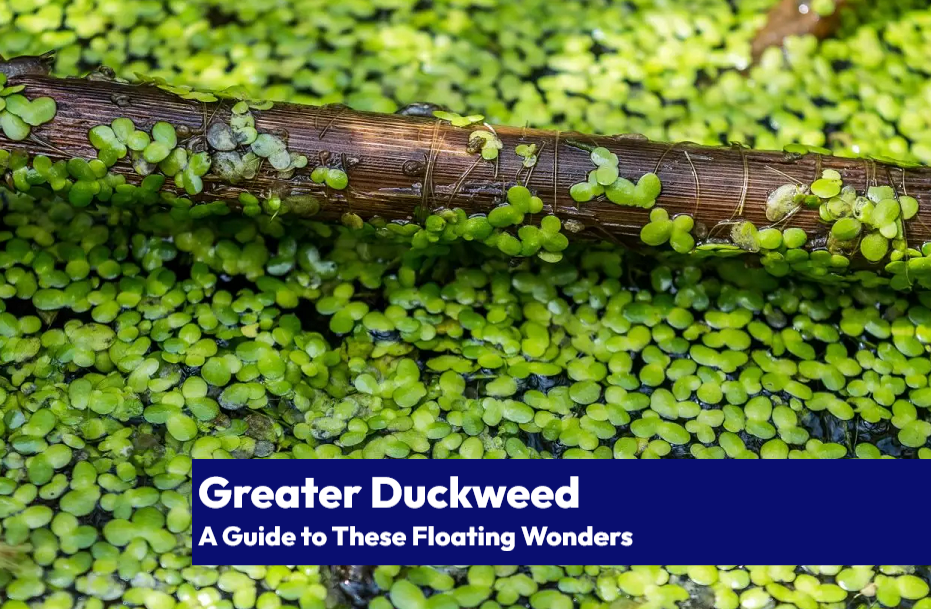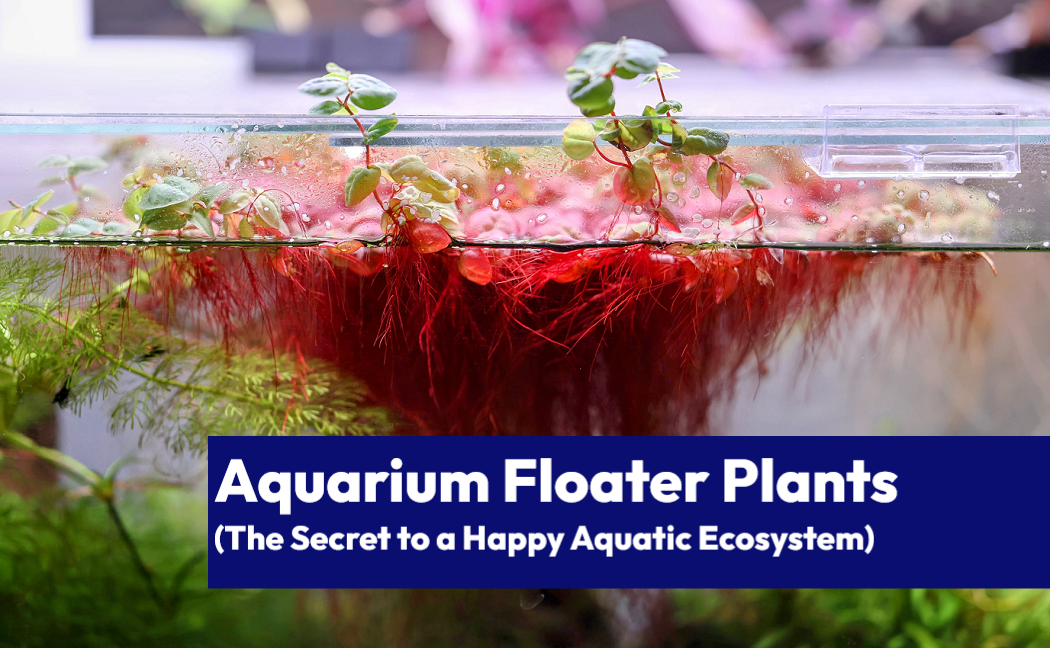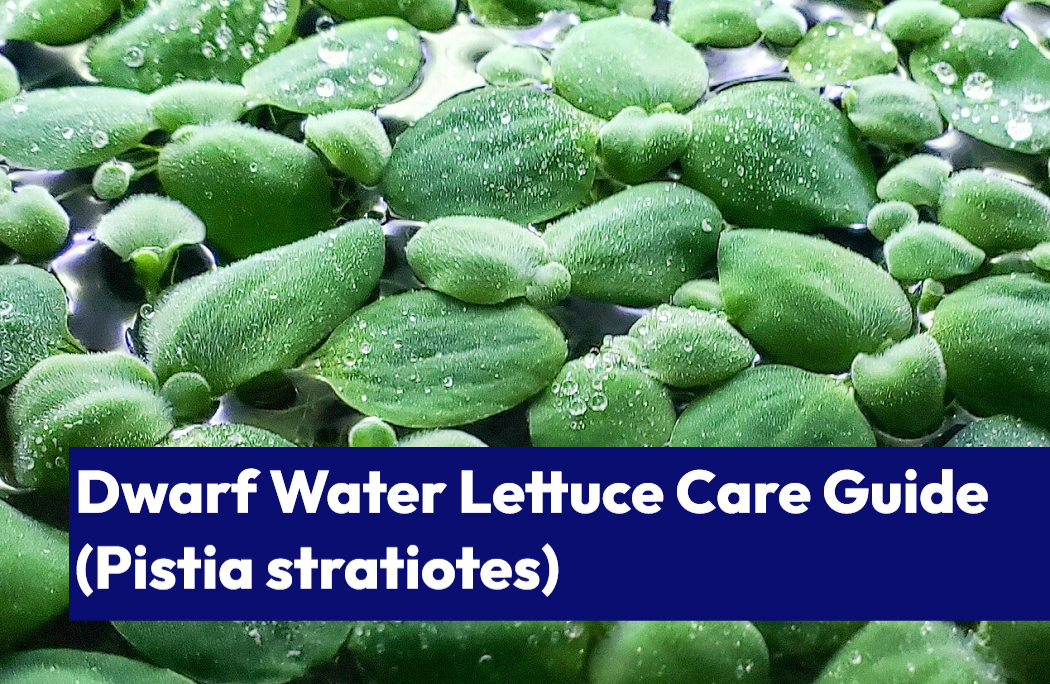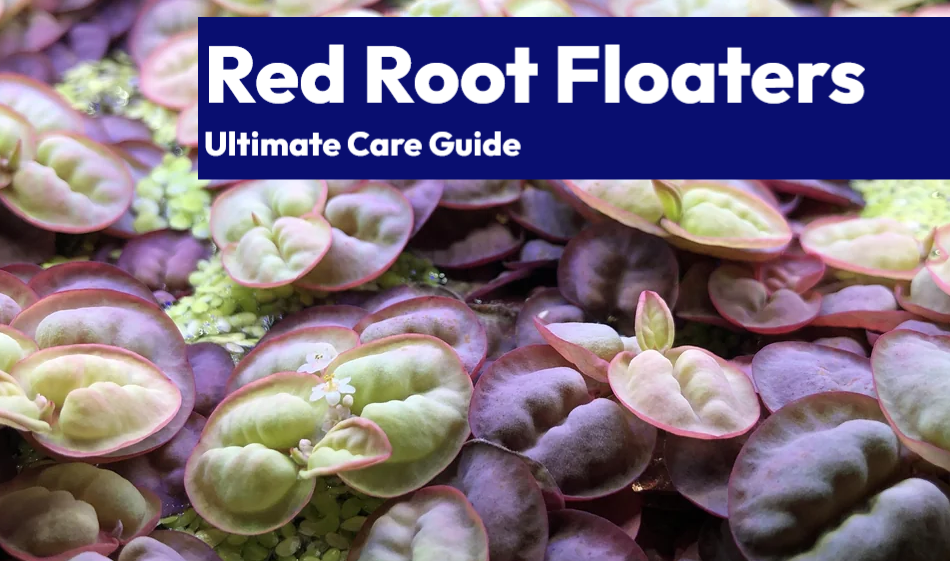Duckweed, also known as water lentils or water lenses, is a type of flowering aquatic plant that floats on or just beneath the surface of still or slow-moving bodies of water. It belongs to the subfamily Lemnoideae within the family Araceae and is characterized by its simple structure, lacking an obvious stem or leaves.
The greater part of each duckweed plant is a small “thallus” or “frond” structure only a few cells thick, that often has air pockets, called aerenchyma, which allow it to float on or just under the water surface. Depending on the species, each duckweed plant may have no root or may have one or more simple rootlets.
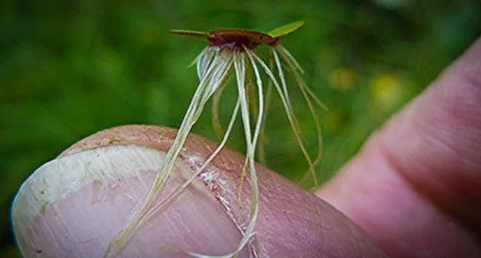
Duckweed in the Aquarium
Are you looking for a low-maintenance, hardy, and easy-to-grow plant for your aquarium? Look no further than duckweed! This tiny plant, scientifically known as Lemna Minor, is a floating sensation that adds a touch of green to your tank and has quite a few positive uses, if the maintenance of it isn’t enough to put you off.
Duckweed Size
Duckweed is a small plant that produces tiny, oval leaves measuring only 0.12 inches. These leaves are light green in color and float on the surface of the water, giving your tank a clover-like appearance. The leaves also have root-like structures that hang down underneath, adding to the plant’s charm.
Duckweed Growth Rate
Duckweed is a fast-growing plant that can cover the surface of an average aquarium in just one week! This is due to its vegetative reproduction process, where each floating leaf produces more floating leaves. And the best part? Duckweed is great for aquariums with heavy biological loads, as it will absorb excess nutrients from the water column to keep your tank free of algae.
Do Fish Eat Duckweed?
Many fish, especially goldfish, love to munch on duckweed. It also provides shade and cover for your fish, making them feel more secure. Here are a list of aquarium fish that are known to eat duckweed:
- Betta Fish
- Guppies
- Mollies
- Plecostomus
- Swordtails
- Danios
- Barbs
- Angelfish
- Catfish
- Goldfish
- Rosy Barbs
- Gouramis
- Discus Fish
Duckweed Care
Duckweed is a low-maintenance plant that requires minimal care. Just make sure to regularly thin out excess material and balance it out with other floating plants like water lettuce or dwarf baby tears.
Perfect for Any Tank
Duckweed can thrive in a large temperature range, from 41°F to 95°F, making it suitable for tanks with varied water conditions. And, with its low to moderate lighting requirements, you won’t have to worry about it taking over your tank.
Is Duckweed Good for Your Aquarium?
Duckweed is an incredibly versatile and beneficial plant for your tank. Here are some of the many ways it can improve your aquarium:
- Improves water quality: Duckweed helps to remove pollutants and waste from the water. It consumes nitrates, nitrites, and other toxic chemicals, which are harmful to fish, and keeps the ammonia, nitrites, and nitrates levels low in the tank. The plant also absorbs carbon dioxide from the water, improving the overall water quality.
- Improves oxygen levels: Duckweed can circulate air and produce oxygen in the tank, improving the oxygen level. However, it’s important to remove dead duckweed promptly, as it will consume oxygen as it decomposes.
- Prevents algae growth: Duckweed can cover the surface of the water, reducing the amount of light that enters the tank and preventing the growth of algae. The plant also absorbs the nutrients that are necessary for algae growth, ultimately killing the algae.
- Provides food for fish: Duckweed is a great food source for the fish species that will eat it. It’s high in protein and low in fiber, making it a great alternative to meat.
- Provides a natural habitat: Duckweed’s green color and clover-like appearance creates a natural-looking habitat for fish. This is especially beneficial for fish that need a place to hide and rest.
- Provides shade and protection: Duckweed reduces the evaporation rate of water and provides shade for your fish. It also covers the surface of the water, preventing fish from jumping out of the tank.
How to Get Rid Of Duckweed In An Aquarium
For some hobbyists, duckweed can be a real headache for aquarium owners. This floating plant is notorious for taking over tanks, but with the right steps, you can get rid of it once and for all if you’ve had enough of it. Here’s a guide to help you do just that!
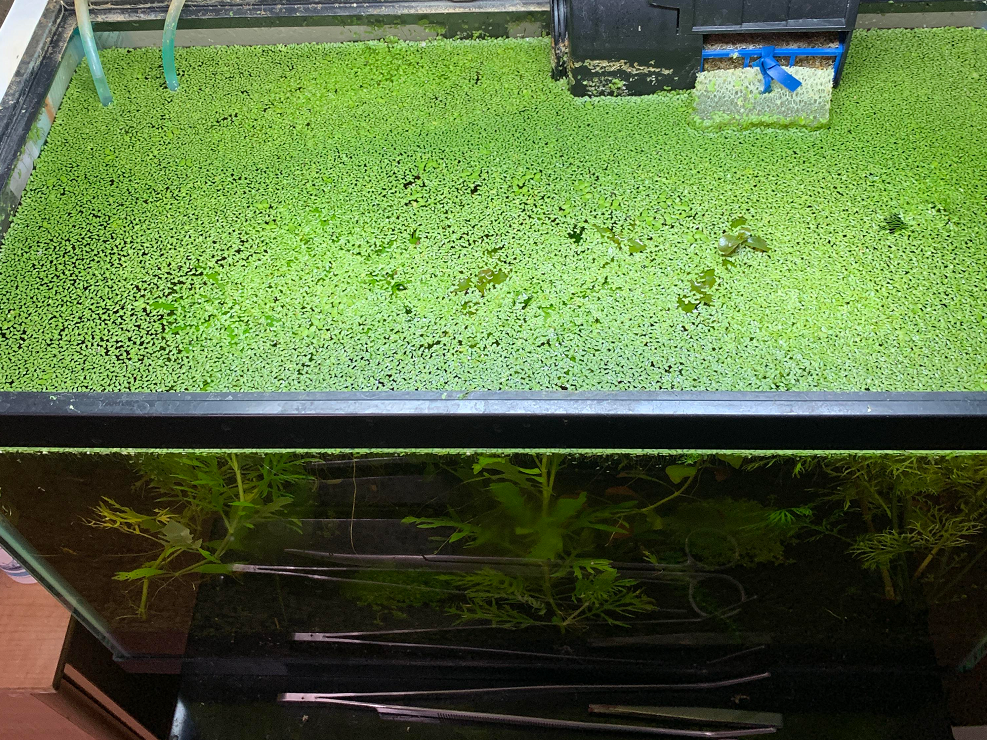
Disadvantages of Duckweed
While duckweed has its benefits, it also comes with some challenges:
- Nutrient uptake: Duckweed will continue to take up nutrients even after the excess has been removed, which can lead to overgrowth and depletion of essential nutrients for other plants in the aquarium.
- Equipment clog: Duckweed can get caught in filter intakes and powerheads, making it difficult to remove and requiring extra maintenance.
- Shade: Duckweed can also shade other plants that need high light, making it difficult for them to thrive.
Is Duckweed Harmful to Fish?
Duckweed is not harmful to fish as long as it’s not allowed to grow out of control. However, if duckweed covers the entire water surface, it can shade other plants and decrease the overall oxygen production in the water, which could harm other aquatic species.
Preventing Duckweed
The best way to deal with duckweed is to prevent it from ever being introduced in the first place or taking over your tank. Here are a few tips to help you do just that:
- Be careful when buying new aquatic plants. Duckweed can be hard to spot, so make sure to inspect any plants thoroughly before you buy them.
- If you’re buying in-vitro plants, you’re guaranteed to get duckweed-free plants. For other forms of cultivation, however, you’ll need to be extra careful.
- Rinse your plants under running water to remove any duckweed that might be hiding on them.
- Keep a close eye on your tank during the first few days after you set it up. Check for any emerging duckweed and remove it immediately.
Fighting Back
If duckweed has already taken over your tank, don’t worry, there are still things you can do to get rid of it. Here are a few options:
- Get a duckweed-eating fish. Gouramis of the genus Trichogaster are known to eat duckweed, but keep in mind that they have specific requirements in terms of water quality and tank size.
- Manually remove the duckweed. This is probably the easiest method, but it will take time and effort. Start by scooping up big chunks of duckweed with a container, then use a fish net to remove any remaining fragments. Be extra careful to check for stray duckweed leaves on any objects protruding from the water, like technical equipment or hardscape.
- Remove technical equipment. To get rid of all the duckweed, you’ll need to remove any technical equipment that’s protruding from the water and clean it outside of the tank. Lowering the water level can also help, as duckweed often sticks to the aquarium glass. For hardscape like driftwood covered in moss, you’ll need to pick off the pieces of duckweed one by one with tweezers.
- Use a surface skimmer. A small skimmer like the Eheim 350 is a useful tool for collecting floating duckweed leaves that are hard to get with a net. Just keep in mind that its capacity is limited.
Getting rid of duckweed in your aquarium can be a challenge, but with the right steps, you can do it. Follow the tips in this guide, and you’ll be well on your way to a duckweed-free tank. And remember, even after you’ve removed all the visible duckweed, you’ll need to keep a close eye on your tank for the next week or two to make sure it doesn’t come back.
Duckweed In Ponds
Duckweed is a common problem in many ponds, and getting rid of it can be a challenge. But don’t worry, there are several options available to control this pesky plant. In this section, we’ll go over the non-herbicide and herbicide management options, so you can choose the best solution for your pond.
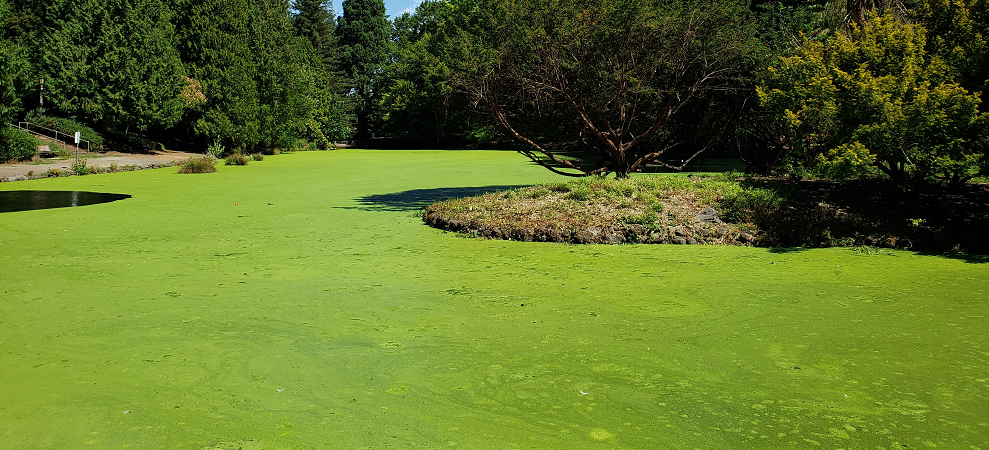
Natural & Non-Herbicide Management Options
- Physical Management Options
One of the easiest ways to remove duckweed from your pond is by raking or seining it from the surface. This method is a physical, hands-on approach that can be time-consuming, but it’s also the most natural way to get rid of duckweed.
- Biological Management Options
Tilapia are a warm water species that love to munch on duckweed, but they can only survive in temperatures above 55°F. This means that tilapia can only be stocked in your pond from mid-April to November. The recommended stocking rate is 15 to 20 pounds of mixed-sex adult Mozambique Tilapia per surface area. However, if your pond has a large bass population, tilapia may not be effective due to predation. Before stocking tilapia, be sure to check with your local county extension agent for the legality of this method in your area.
Ducks also eat duckweed, but they don’t always control it.
Herbicide Control Options
Duckweed can be a real pain in the pond, but don’t worry, we’ve got you covered! There are several herbicides that have been proven to effectively get rid of duckweed.
But before we dive into the specifics, it’s important to remember that safety always comes first. Make sure to always read the product label for directions and precautions, as it is the law. Check for specific water use restrictions and always follow all label directions.
The Top 5 Herbicides for Duckweed
- Carfentrazone – This is a contact herbicide that is absorbed through the leaves. It acts quickly and kills all plant cells it comes in contact with. Trade and product names include Stingray.
- Diquat – This is a contact algaecide and herbicide that acts quickly and kills all plant cells it comes in contact with. Trade and product names include Reward, Harvester, Tribune, Tsunami DQ, Diquat SPC2L, and Weedtrine.
- Fluridone – This is a broad spectrum, systemic herbicide that is absorbed and moves within the plant to the site of action. It tends to act more slowly than contact herbicides. Trade and product names include Sonar and Avast.
- Flumioxazin – This is a water-dispensable granule that should be sprayed or injected after mixing. It’s a broad spectrum, contact herbicide that acts quickly. Trade and product names include Clipper.
- Penoxsulam – This is a broad spectrum, systemic herbicide that may be sprayed directly onto emergent plants or applied directly into the water. Trade and product names include Galleon.
Precautions
Remember, there is a danger of oxygen depletion after the treatment due to the decomposition of the dead plant material. This can kill fish in the pond, so it’s important to be careful. If your pond is heavily infested with weeds, consider treating it in sections and letting each section decompose for about two weeks before treating another section. Aeration, especially at night, for several days after treatment may also help control the oxygen depletion.
Duckweed in Natural Environments
Duckweeds are often associated with fertile, even eutrophic conditions and can be spread by waterfowl and small mammals, transported inadvertently on their feet and bodies, as well as by moving water. In water bodies with constant currents or overflow, the plants are carried down the water channels and do not proliferate greatly. However, in some locations, a cyclical pattern driven by weather patterns exists in which the plants proliferate greatly during low water-flow periods, then are carried away as rainy periods ensue.
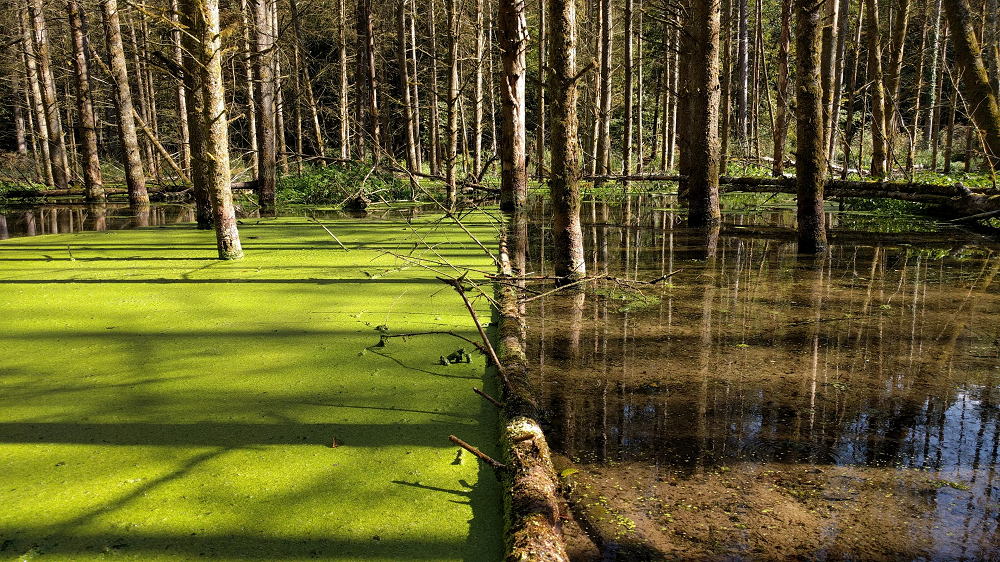
One of the more important factors influencing the distribution of wetland plants, and aquatic plants in particular, is nutrient availability. Duckweeds are important high-protein food sources for waterfowl, and they provide cover for the fry of many aquatic species. They also provide shelter for pond-water species such as bullfrogs and fish such as bluegills, and they can reduce certain light-generated growths of photoautotrophic algae.
Duckweed as Human Food Crop
In some parts of Southeast Asia, duckweed is consumed as a staple food, and in Israel, it’s cultivated as a vegetable. It produces more protein per square meter than soybeans, so sometimes it’s cited as a significant potential food source. Some initial investigations into the extent to which duckweed could be introduced in European markets show little consumer objection to the idea. NASA’s Caves of Mars Project even identified duckweed as a top candidate for growing food on Mars.
Duckweed as Invasive Species
Despite some of its benefits, because duckweed thrives in high-nutrient wetland environments, it can be seen as a nuisance species when conditions favor excessive proliferation in environments that are traditionally low in nutrients or oligotrophic. For example, in the Everglades, a mostly oligotrophic environment, excess chemicals carried into its waterways by storm runoff or surface runoff can cause the invasion of duckweed, which can then displace other native species such as sawgrass and result in widespread changes to the ecology of native sawgrass and slough habitats.
How Duckweed Pollinates
The flowers of duckweeds are microscopic and consist of two staminate flowers and one pistillate flower. They are pollinated by flies, mites, small spiders, and even bees that are attracted by sticky secretions from the stigma. In rare cases, duckweeds can also be pollinated through the collision of adjacent floating stems.
Most duckweeds reproduce asexually through the formation of chains of new stems from vegetative buds. Some species can also produce specialized buds called turions that break off the parental stem and sink to the bottom of a lake or pond to overwinter. In the spring, the turions rapidly begin to grow and float back to the surface, becoming a new duckweed stem.
Growth of Duckweeds
Reproduction in duckweed is mostly by asexual budding, which occurs from a meristem enclosed at the base of the frond. Occasionally, tiny “flowers” consisting of two stamens and a pistil are produced for sexual reproduction. The fruit produced through this occasional reproduction is a utricle, and a seed is produced in a bag containing air that facilitates flotation.
In simpler terms, duckweeds grow quickly and produce new offshoots rapidly, which is why they can become a nuisance to humans. However, scientists have recently come to appreciate their fast growth rate and are using them for bioremediation and as a source of livestock feed and fertilizer. Researchers are even developing techniques to use genetically modified duckweeds to synthesize insulin and other commercially valuable proteins.
Nine duckweed species occur in North America, with the most widespread species being the common duckweed (L. minor). Identifying duckweeds to species can be challenging due to their minute size and lack of showy floral characters. However, stem size and the number of roots can help distinguish different species.
Taxonomy
Duckweeds belong to the order Alismatales and the family Araceae, and their position within the family has been the subject of some debate. However, most systematists now consider them to be part of the Araceae family. The genera of duckweeds are Spirodela, Landoltia, Lemna, Wolffiella, and Wolffia.
Frequently Asked Questions
Q: What is duckweed?
A: Duckweed is a type of floating plant that belongs to the Araceae family and is often found in slow-moving lakes, rivers, and pond systems. It has been used in the aquarium hobby for nutrient control and for its aesthetic qualities.
Q: How to get rid of duckweed?
A: To get rid of duckweed, manual removal is the best method. You can use your hand or a net to remove clumps of duckweed in an aquarium, or use a skimmer on a windy day in a pond to push the plants to one side. Another way to control duckweed is to increase the amount of water surface agitation, but this may cause the plants to rot and will need to be removed immediately.
Q: Do ducks eat duckweed?
A: Yes, ducks do eat duckweed. It is a rich food source for many aquatic species, including ducks.
Q: How to grow duckweed?
A: To grow duckweed, you need to create an environment that mimics its natural habitat, which includes slow-moving water with a neutral pH around 7.0 and a temperature range between 42-92° F (5.6-33.3° C). Duckweed grows best in tropical settings with full light, but it can also adapt to more acidic or basic conditions with lower light.
Q: What eats duckweed?
A: Many species of fish, including goldfish, carp, koi, and tilapia, and some bird species, will happily munch on duckweed.
Q: Where to buy duckweed?
A: You can buy duckweed from aquarium supply stores, pet stores, or online retailers that specialize in aquatic plants.
Q: Where can I buy duckweed seeds?
A: You can buy duckweed seeds from aquarium supply stores, pet stores, or online retailers that specialize in aquatic plants.
Q: What does duckweed look like?
A: Duckweed can have up to four leaves per individual plant, with one 0.4-0.8 inch (1-2 cm) root hanging from the center. Each small green leaf is usually rounded or oval-shaped and only a few millimeters long and wide.
Q: How does duckweed reproduce?
A: Duckweed reproduces both sexually, through the production of seeds, and asexually, by fragmentation. A single plant can divide into two separate plants, which can then grow into mature plants.
Q: Is duckweed good for bettas?
A: Duckweed can provide shade and protection for bettas, but it’s important to monitor its growth rate, as it can quickly take up all the nutrients in the tank and shade other plants if they are present. Bettas will occasionally eat it also, and can be a good protein source.
Q: Is duckweed invasive?
A: Yes, duckweed can be invasive in aquatic environments, as it grows quickly and can cover large areas of the surface of a pond or lake.
Q: What is duckweed used for?
A: Duckweed is used for nutrient control in aquariums and ponds, as it can quickly take up excess nutrients and help to stabilize the water quality. It is also used as a food source for livestock and fish, and as a source of proteins for biomedical research.
Q: Can you eat duckweed?
A: Yes, duckweed is edible and is used as a food source in some cultures. It is high in protein and has a slightly bitter taste.
Q: Do goldfish eat duckweed?
A: Yes, goldfish are known to eat duckweed.
Q: How to get rid of duckweed without killing fish?
A: To get rid of duckweed without killing fish, you can manually remove it, increase water surface agitation, or introduce fish species that eat duckweed.
Q: Is duckweed good for ponds?
A: Duckweed can be good for ponds, as it can help control nutrient levels and provide shade and protection for aquatic life. However, its rapid growth rate can also become a problem if not closely monitored.
Q: How to eat duckweed?
A: Duckweed can be eaten raw or cooked, but it has a slightly bitter taste. It is often added to soups or stir-fries, or used as a protein-rich ingredient in smoothies or shakes.
Q: What does duckweed taste like?
A: Duckweed has a slightly bitter taste, but its flavor is largely determined by how it is prepared and combined with other ingredients.
Q: Will copper sulfate kill duckweed?
A: Yes, copper sulfate is a chemical that can kill duckweed. However, it is important to note that copper sulfate is toxic to aquatic life and should be used with caution in aquariums and ponds.
Q: Can you put duckweed in an aquarium?
A: Yes, duckweed can be put in an aquarium as long as it is kept in check and not allowed to take over the entire tank. Duckweed can provide a source of food and shade for some aquatic species and can also help to oxygenate the water.
Q: Do grass carp eat duckweed?
A: Yes, grass carp are known to consume large amounts of duckweed and can be used as a control method for managing duckweed populations in ponds and other bodies of water.
Q: Do guppies eat duckweed?
A: Guppies may consume small amounts of duckweed, but it is not a significant part of their diet.
Q: How to keep duckweed out of filter?
A: Duckweed can be difficult to remove from filters, but one solution is to use a pre-filter to capture the duckweed before it enters the filter. Another option is to adjust the water flow in the filter to minimize the amount of duckweed that accumulates.
Q: Will roundup kill duckweed?
A: Roundup, also known as glyphosate, is a herbicide that can kill duckweed. However, it is important to note that Roundup is toxic to aquatic life and should be used with caution in aquariums and ponds.
Q: Do koi eat duckweed?
A: Yes, Koi will eat duckweed.
Q: Do tadpoles eat duckweed?
A: Tadpoles may consume small amounts of duckweed, but it is not a significant part of their diet.
Q: Does duckweed die in winter?
A: Duckweed can survive in winter under the right conditions, such as in a greenhouse or in warm water bodies. However, it is common for duckweed populations to decline or die off in winter in colder climates.
Q: Does duckweed multiply?
A: Yes, duckweed multiplies rapidly and can quickly spread and take over a pond or other body of water if left uncontrolled.
Q: Does duckweed oxygenate water?
A: Yes, duckweed can help to oxygenate water as it produces oxygen through photosynthesis. However, it can have the opposite and deplete oxygen if allowed to completely cover the surface of a water body and prevent surface agitation.
Q: How fast does duckweed grow in aquarium?
A: The rate of duckweed growth in an aquarium depends on factors such as water temperature, light, and nutrient levels. In optimal conditions, duckweed can double its biomass in just a few days.
Q: Is duckweed algae?
A: No, duckweed is not an algae. It is a type of flowering plant that belongs to the family Lemnaceae.
Q: What animals eat duckweed?
A: Animals that eat duckweed include ducks, geese, koi, grass carp, tadpoles, and some species of fish.
Q: What is duckweed used for in fish tanks?
A: Duckweed can be used in fish tanks as a source of food for the fish and as a source of shade and cover. It can also help to improve water quality by removing excess nutrients and providing oxygen to the water through photosynthesis. However, duckweed can also become a problem in fish tanks if it grows out of control and clogs filters, so it’s important to control its growth.

Tim Priest, a renowned aquarium expert with over 15 years of experience in aquatic gardening and fish education, is dedicated to helping enthusiasts create stunning and thriving aquatic environments. As the founder of LearnTheAquarium.com, Tim shares his wealth of knowledge, passion, and expertise through engaging articles, educational resources, and personalized advice.
Discover the secrets to creating captivating underwater landscapes and maintaining healthy aquatic ecosystems. Join Tim on an exciting journey and let your aquarium adventure begin!
